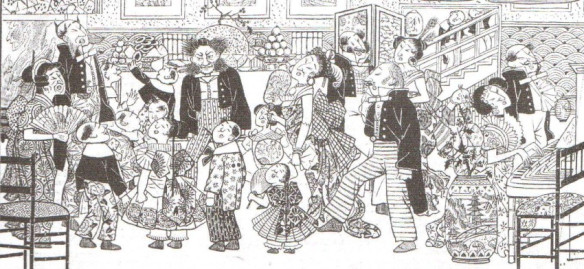 “Two Leagues from Nagasaki there’s a High towering Mountain called Unzen, and on the Top three or four vast Lakes with boiling sulphurous Waters, heated by subterraneous Fires. These Waters break out sometimes in wide Openings and Gapings of the Earth, with whole Mountains of Flames, called by the Japanese the Mouths of Hell… or Infernal Waters. These wide Openings happen only once in Eighteen Years, but then it overflows like a Deluge, with whole Torrents of stinking Waters, mixed with Sulphur and Brimstone, insomuch as one can’t look upon them without Horror. The Waters smoke and boil as if they stood upon a hot Fire, and make so hideous a Noise that we may properly compare them with the Lakes of Brimstone and Fire mentioned in the Apocalypse. For the rest, the Waters are so hot… that the least Drop penetrates to the Bone.”
“Two Leagues from Nagasaki there’s a High towering Mountain called Unzen, and on the Top three or four vast Lakes with boiling sulphurous Waters, heated by subterraneous Fires. These Waters break out sometimes in wide Openings and Gapings of the Earth, with whole Mountains of Flames, called by the Japanese the Mouths of Hell… or Infernal Waters. These wide Openings happen only once in Eighteen Years, but then it overflows like a Deluge, with whole Torrents of stinking Waters, mixed with Sulphur and Brimstone, insomuch as one can’t look upon them without Horror. The Waters smoke and boil as if they stood upon a hot Fire, and make so hideous a Noise that we may properly compare them with the Lakes of Brimstone and Fire mentioned in the Apocalypse. For the rest, the Waters are so hot… that the least Drop penetrates to the Bone.”
Crasset — History of the Church of Japan, 1707.
Eighteen Christians, four of them found among the local baron Matsukura’s own subordinates, were taken in procession up the slopes of Unzen to the boiling lakes. One, gazing upon a Mouth of Hell, brightly opined that for him it would be the Gateway into Paradise. Another shouted praises to Jesu Cristo and hurled himself into the lake, much to the annoyance of another Christian, Paul Uchibori, who warned the others that they were there to be martyred, not to commit the sin of suicide. Thereafter, the Christians were thrown one-by-one into the waters of Unzen, all except Paul, who was vengefully dipped headfirst several times.
It was not the last time that Old Matsukura’s men would climb Unzen with a party of martyrs. One of Matsukura’s own officers turned himself in at Shimabara, claiming that he had gone into hiding in Fukae, but had realised that his lord would get into trouble with the Shogun if it was found out that he had allowed a Christian to escape. After making this incredible confession, he was duly sent up the mountain with another group of Christians, whereupon Old Matsukura’s men attempted to get some better results.
Simply killing the Christians had been proven unproductive, particularly since so many of them went uncomplaining or even gratefully to their deaths. Instead, Matsukura’s men tried to prolong their agony, dipping them in and out of the lakes, splashing them repeatedly with scalding water, and even slicing gashes into their flesh, to increase the pain. When none of this had any appreciable affect, they resorted to a far crueller method. They separated one John Chizaburo from the survivors, and allowed him to sit down and rest for a while. They then told the survivors that the man had been allowed to sit down because he had agreed to cast aside his Christian faith.
 It was calculated to wound the believers at a spiritual level and almost worked, but for John Chizaburo unhelpfully bellowing: ‘I declare before you all, that I live and die a Christian.’
It was calculated to wound the believers at a spiritual level and almost worked, but for John Chizaburo unhelpfully bellowing: ‘I declare before you all, that I live and die a Christian.’
Eventually, the torturers gave up, tied the survivors together and doused them in scalding water until they died. The pitiful corpses, which ‘appeared as if they had been flayed alive,’ were then weighted with stones and dumped in the lake, in an attempt to discourage other Christians from filching holy relics.
Excerpted from Christ’s Samurai: The True Story of the Shimabara Rebellion by Jonathan Clements.





 The concept of binge-watching is nothing new to readers of this column – indeed, it was first introduced
The concept of binge-watching is nothing new to readers of this column – indeed, it was first introduced 
